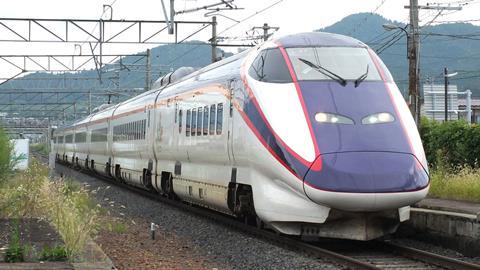
JAPAN: Construction of a base tunnel below the Ou mountain range on the Yamagata mini-Shinkansen moved a step closer on October 24 when a Memorandum of Understanding promoting the project was agreed between JR East and Yamagata Prefecture.
The Comprehensive Partnership Agreement and Memorandum was signed by Yamagata Prefecture Governor Mieko Yoshimura and JR East Group Management Strategy Managing Director Chiharu Watari.
The base tunnel, for which JR East had conducted a survey in 2017, would require construction of a new railway from Niwasaka to Sekine, just south of Yonezawa station. No less than 23∙1 km of the 24∙9 km line would run in tunnel, mostly to the north of the existing 88 km Fukushima – Yamagata route. To be built on a gently-curved alignment, the tunnel would trim journey times between Fukushima and Yamagata by around 10 min thanks to a line speed of up to 200 km/h.
The tunnel would avoid the need for Yamagata mini-Shinkansen services to negotiate the formidable Itaya Toge pass through the Ou mountains west of Fukushima. Gradients range from 3∙0% to 3∙8% and the line reaches an altitude of 548 m. Separate alignments were needed for each of the line’s two tracks, requiring construction of several single-track tunnels; some local stations were built inside snowsheds.
The curvature and steep grades limit train speeds to 55 km/h or less, and the line is vulnerable to heavy rain and snowfall as well as high winds. Between 2011 and 2017 a total of 410 Yamagata mini-Shinkansen services were either suspended or delayed, and 40% of these incidents occurred on the line over the Itaya Toge pass.
If the ¥150bn base tunnel is authorised, detailed design would take five years and construction another 15 years. The cost could increase by ¥12bn if the tunnel were to be built with a cross-section large enough to permit the line to be upgraded to the full Shinkansen loading gauge.
At the moment, Shinkansen services from Tokyo to Yamagata and Shinjo rely on JR East’s fleet of Series E6 trainsets. These were built with a small body profile to fit within the structures of the 1 067 mm gauge Fukushima – Yamagata route that was converted to 1 435 mm gauge to form the Yamagata mini-Shinkansen, which opened in 1992.
Yamagata mini-Shinkansen trains share the route with infrequent local services operated by Class 719 EMUs. These offer similar journey times to the mini-Shinkansen trains between Yonezawa and Fukushima, despite several intermediate stops. None of the intermediate stations are close to any large centres of population, and this scenic stretch of line may close once the base tunnel is open, probably in the late 2030s.
- Also on October 24, JR East Tohoku Division Executive Director Hiroyuki Mitsubayashi signed a Comprehensive Partnership Agreement with Yamagata Prefecture Governor Mieko Yoshimura about revitalising the Yamagata Prefecture rail network.
















